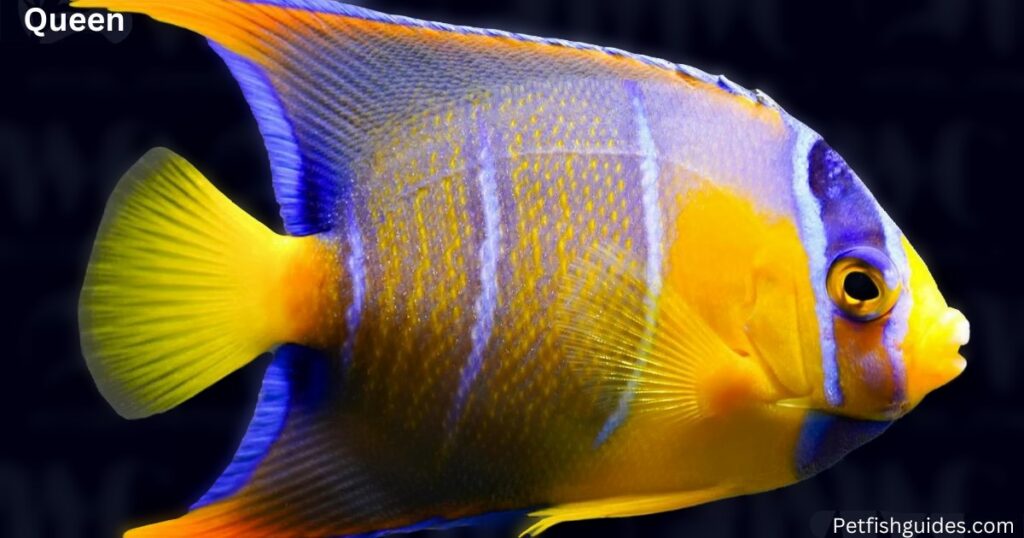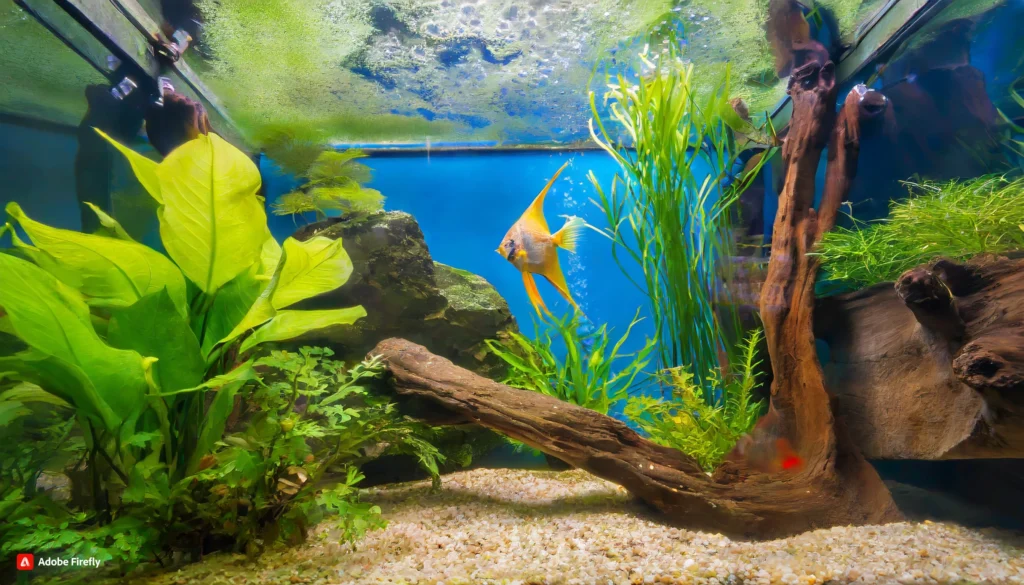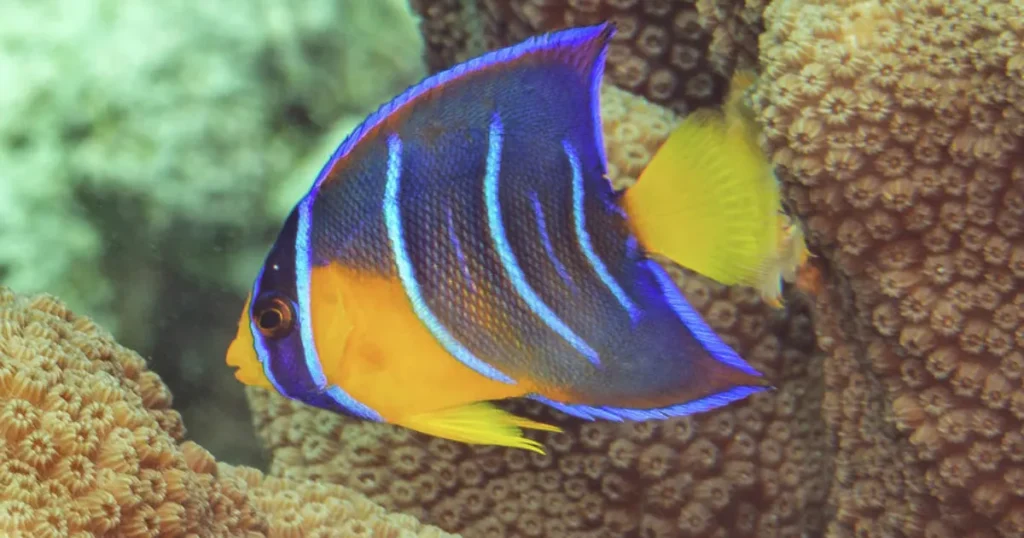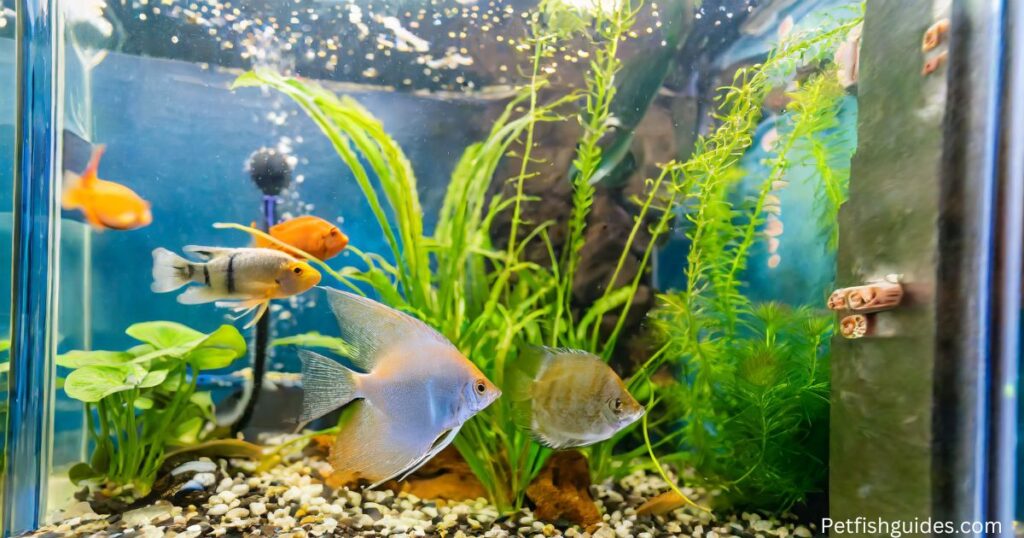With their bright, captivating patterns and graceful movements, queen angelfish are truly gems of the underwater world. These iconic fish are highly sought-after by advanced aquarists, but require specialized care and setup. This detailed guide will provide aquarists with comprehensive information on keeping healthy, thriving queen in home aquariums. We will cover everything from distinguishing juveniles to cultivating adults, ideal tank parameters, habitat design, nutrition, and potential tankmates for this regal species. Read on to learn the keys to successfully maintaining the angelfish long-term.

Queen Angelfish Identification
The scientific name for the queen angelfish is Holacanthus ciliaris. As members of the Pomacanthidae family, they are distinguished by their deep, laterally compressed bodies and bold color patterns. Queen angelfish stand apart thanks to their vivid, alternating stripes of electric blue and brilliant yellow. Their dorsal, anal, and caudal fins are elongated and flowing. Fully grown adults reach about 12 inches in total length.
Juveniles look entirely different than mature adults. Young queens are colored jet black and pearly white in vertical stripes all over their body. This cryptic banding helps camouflage juvenile queens against the reef until they reach adulthood. The juvenile bands slowly transition to the flowing horizontal stripes around 9 months to 2 years post-hatching.
Queen Angelfish Habitat
In the wild, queen angelfish inhabit shallow coral reef environments and lagoons. Their range includes the Caribbean Sea, Gulf of Mexico, Bermuda, and as far south as Brazil. Queens frequent reef areas dense with sponges, algae, and ample hiding spots. They are found in warm, tropical waters ranging from 75-80°F, with a pH of 8.1-8.4 and medium to high salinity. Replicating these conditions closely provides the ideal queen angelfish aquarium habitat.

Replicating Ideal Conditions in Aquariums
Maintaining optimal water conditions is crucial for the well-being of these fish. Invest in quality filtration systems, and strive to keep the water temperature between 75-80°F with a pH of 8.1-8.4.
Providing plenty of cured live rock is key, as queens will graze upon the algae and microfauna covering the rockwork. Live rock also furnishes shelter for these reclusive fish. Allow open swimming space since queens travel long distances daily in the ocean. Moderate water movement and lighting that mimics natural daylight cycles are also important habitat considerations.
Importance of Proper Habitat for Well-being
Creating an environment that mirrors their natural habitat reduces stress and promotes overall health. Provide ample hiding spots and open swimming spaces, allowing these magnificent creatures to exhibit their natural behaviors.
Juvenile Queen Angelfish and Development
The juvenile phase of queen angelfish is one of the longest among marine species. Young queens spend anywhere from 9 months up to 2 years in their cryptic black and white banding before metamorphosing into adults. Their change in coloration happens gradually, beginning with the head and slowly spreading back across the body over several months.
During this prolonged juvenile period, young queens tend to be very shy and reclusive. They will dart into hiding at any perceived threat. Providing ample live rock, overhangs, and coral nooks helps juveniles feel secure until they reach adulthood. Appropriate tankmates that ignore juvenile queens are also recommended.

Once they obtain their regal adult patterning, queen angelfish transform in both appearance and attitude. No longer timid, adult queens display confidence in inhabiting swimming space out in the open. Providing proper habitat, tankmates, and water quality will ensure your juvenile queen has the best chance of surviving to display her full majestic beauty.
Description of Adult Queen.
Mature queen angelfish are a sight to behold. Their bodies are covered in electric blue and brilliant yellow stripes, terminating in a dazzling yellow-ringed black spot near the tail. Their dorsal and anal fins extend nearly the full length of their bodies, rippling gracefully with each swim stroke. Queens have a deep, laterally compressed shape that allows them to slice smoothly through the water column.
Adult queen angelfish primarily graze on algae, sponges, and other aufwuchs covering the reef structure. They establish distinct feeding territories which they patrol daily. Queen angelfish often form loose harems, with one larger dominant male presiding over several females. The males actively court females through spectacular aerial displays during spawning periods.
Providing ample live rock, algae growth, and a balanced diet are key to keeping adult queens healthy and vibrant in home aquaria. Ensure any tankmates are peaceful, and avoid overcrowding. Adult queens require pristine water quality and regular water changes as well to thrive long-term.
Queen Angelfish Diet and Feeding
Queen angelfish are omnivores, meaning they consume both plant and animal material. Their diet differs somewhat between juveniles and adults. Young queens feed on tiny zooplankton like copepods, mysis shrimp, and amphipods. Adults largely graze on sponges, tunicates, and algae growing on the reef structure.

In captivity, provide a variety of foods including:
- Marine herbivore flakes and pellets
- Spirulina, nori, blanched vegetables
- Live, frozen, or freeze-dried mysid shrimp
- Chopped seafood like shrimp, squid, mussel, and clam
- Occasional vitamin-enriched brine shrimp
- Quality angelfish preparations with sponge and algae
Feed juveniles at least 3 times per day. Adults can be fed twice daily, with ample algae and aufwuchs growth in the tank for supplemental grazing. Use an automatic fish feeder for consistency. Soak dried foods prior to feeding. Queen angelfish are prone to bloating, so feed a variety of small meals and closely monitor their intake.
Queen Angelfish Tank Size and Setup
These angelfish require large, well-established aquariums to thrive. The absolute minimum tank size is 75 gallons for a pair, with 125 gallons or more highly recommended. This allows plenty of horizontal swimming space for these active fish. Remember queen angelfish grow to 12 inches in length and are laterally compressed.

The aquarium should also be longer than tall, providing the swimming room queens naturally utilize on reefs. Incorporate a deep sand bed at least 4 inches deep for grazing. Place ample live rock tightly together on one side, leaving a large open swimming space across a majority of the tank. Moderate water movement and efficient filtration are imperative for queen angelfish health.
Water Parameters
Consistent, pristine water quality is crucial for queen angelfish. Monitor and maintain the following aquarium conditions:
- Temperature between 75-80°F
- pH stable around 8.1 to 8.4
- Alkalinity 3-5 dKH
- Calcium 400-450 ppm
- Specific gravity 1.020-1.025
- Ammonia, nitrite at 0 ppm
- Nitrate below 20 ppm
Test alkalinity, calcium, nitrate, and other parameters weekly until stable. Invest in a high-quality protein skimmer, ozone generator, and efficient filtration system. Perform 25% partial water changes every 1-2 weeks. At the first sign of deteriorating water quality, queen angelfish health will decline rapidly. Maintaining excellent water quality is key to their longevity in home aquariums.
Tankmates and Reef Compatibility
Most queens adapt well to community aquariums with appropriate tankmates. Avoid housing them with other angelfish species, which may incite aggression. Also use caution when mixing with surgeonfish and butterflyfish, as nipping can occur over territory. Generally avoid fast, aggressive species prone to harassment.
Good community tankmates include peaceful wrasse, dwarf angels, dottybacks, hawkfish, gobies, blennies, chromis, clownfish, and non-aggressive damselfish. Always introduce tankmates simultaneously as juveniles when possible. Queen angelfish can be reef-safe, ignoring most corals and sessile invertebrates. However, they may nip at polyps and clams. Avoid housing with large-polyped stony corals and tridacnid clams to be safe.
FAQs.
How long do queen angelfish live?
In ideal aquarium conditions, queens can live 10-15 years. Ensure excellent water quality, proper nutrition, and habitat to maximize their lifespan.
How fast do queen angelfish grow?
They grow relatively quickly, reaching 6 inches within their first year. Their growth rate slows as they near full adult size around 12 inches long. It takes 1-2 years for juveniles to transition into adult coloration.
Are queen angelfish reef safe?
Queen angelfish are generally considered reef safe, as they will not bother most corals, shrimp, crabs, snails, and other cleaning creatures. However, they may nibble on large polyp stony corals and clams, so avoid housing with these.
What do I feed queen angelfish?
Offer a varied diet including meaty items like shrimp, marine herbivore pellets, nori, spirulina, and quality angelfish preparations. Feed juveniles small meals 3-4 times daily and adults 1-2 times per day.
Are queen angelfish aggressive toward other fish?
Queen angelfish are generally peaceful but can show aggression toward other angelfish, surgeonfish, and butterflyfish. Avoid these tankmates and choose peaceful community species instead.
Conclusion
Queen angelfish are truly iconic reef inhabitants, commanding awe with their bright, flowing elegance. While they require an experienced aquarist ready to provide a large established tank and pristine water quality, the rewards of cultivating queens are great. Give them ample space, nutritious foods, proper tankmates, and excellent care, and queen angelfish will showcase their iconic beauty for years to come. For those dedicated aquarists ready to invest in their success, this guide covers all the essentials of queen angelfish husbandry from juvenile development to striking adults. Bring a touch of regal splendor to your marine aquarium with the queen.
